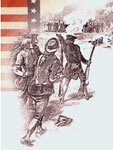Western Gateway Heritage State Park
A former railroad yard, this urban park uses historical artifacts and exhibits to bring to life the controversial and danger-filled construction of the Hoosac Tunnel, one of the greatest engineering feats of the 19th century. The tunnel was dug 4.75 miles through Hoosac Mountain, linking Massachusetts to Albany, NY. 200 men lost their lives building the tunnel, which is still being used today. An audio-visual presentation takes visitors back in time, where the sounds of dripping water, pickaxes against stone, explosions, and debates recreate the hardships and heroism of the tunnel's construction. Outside, several beautifully restored buildings that were once used to store freight and commodities surround a cobblestone courtyard. The buildings are listed on the National Register of Historic Places. Programs such as concerts, walking tours, arts and crafts, and environmental education are offered regularly to the public. In addition, the gallery has become well known for its exhibits that feature work by area artists and historical themes.
The park offers exhibits, a short film, tours, and occasional recreational and educational events.
